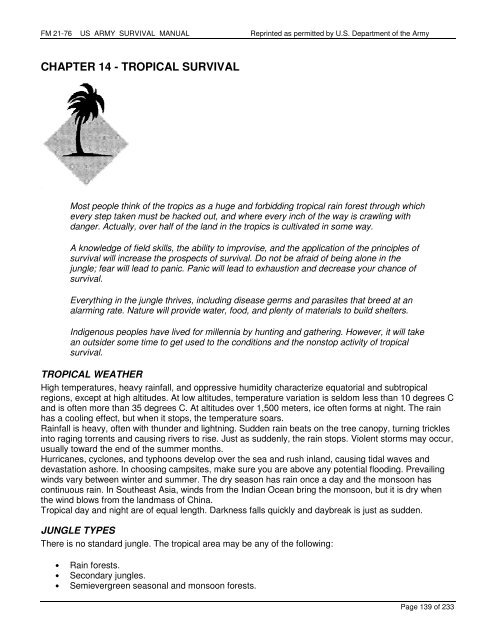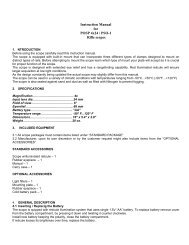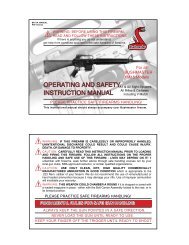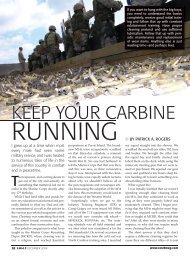FM 21-76 US ARMY SURVIVAL MANUAL - AR15.com
FM 21-76 US ARMY SURVIVAL MANUAL - AR15.com
FM 21-76 US ARMY SURVIVAL MANUAL - AR15.com
You also want an ePaper? Increase the reach of your titles
YUMPU automatically turns print PDFs into web optimized ePapers that Google loves.
<strong>FM</strong> <strong>21</strong>-<strong>76</strong> <strong>US</strong> <strong>ARMY</strong> <strong>SURVIVAL</strong> <strong>MANUAL</strong> Reprinted as permitted by U.S. Department of the Army<br />
CHAPTER 14 - TROPICAL <strong>SURVIVAL</strong><br />
Most people think of the tropics as a huge and forbidding tropical rain forest through which<br />
every step taken must be hacked out, and where every inch of the way is crawling with<br />
danger. Actually, over half of the land in the tropics is cultivated in some way.<br />
A knowledge of field skills, the ability to improvise, and the application of the principles of<br />
survival will increase the prospects of survival. Do not be afraid of being alone in the<br />
jungle; fear will lead to panic. Panic will lead to exhaustion and decrease your chance of<br />
survival.<br />
Everything in the jungle thrives, including disease germs and parasites that breed at an<br />
alarming rate. Nature will provide water, food, and plenty of materials to build shelters.<br />
Indigenous peoples have lived for millennia by hunting and gathering. However, it will take<br />
an outsider some time to get used to the conditions and the nonstop activity of tropical<br />
survival.<br />
TROPICAL WEATHER<br />
High temperatures, heavy rainfall, and oppressive humidity characterize equatorial and subtropical<br />
regions, except at high altitudes. At low altitudes, temperature variation is seldom less than 10 degrees C<br />
and is often more than 35 degrees C. At altitudes over 1,500 meters, ice often forms at night. The rain<br />
has a cooling effect, but when it stops, the temperature soars.<br />
Rainfall is heavy, often with thunder and lightning. Sudden rain beats on the tree canopy, turning trickles<br />
into raging torrents and causing rivers to rise. Just as suddenly, the rain stops. Violent storms may occur,<br />
usually toward the end of the summer months.<br />
Hurricanes, cyclones, and typhoons develop over the sea and rush inland, causing tidal waves and<br />
devastation ashore. In choosing campsites, make sure you are above any potential flooding. Prevailing<br />
winds vary between winter and summer. The dry season has rain once a day and the monsoon has<br />
continuous rain. In Southeast Asia, winds from the Indian Ocean bring the monsoon, but it is dry when<br />
the wind blows from the landmass of China.<br />
Tropical day and night are of equal length. Darkness falls quickly and daybreak is just as sudden.<br />
JUNGLE TYPES<br />
There is no standard jungle. The tropical area may be any of the following:<br />
• Rain forests.<br />
• Secondary jungles.<br />
• Semievergreen seasonal and monsoon forests.<br />
Page 139 of 233








